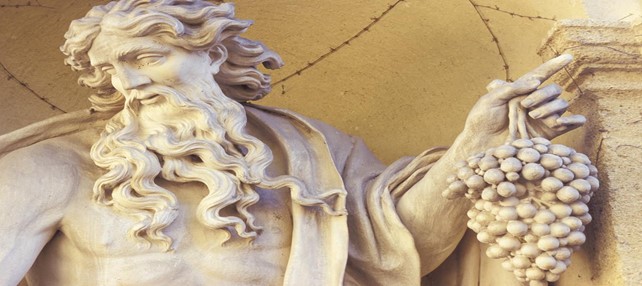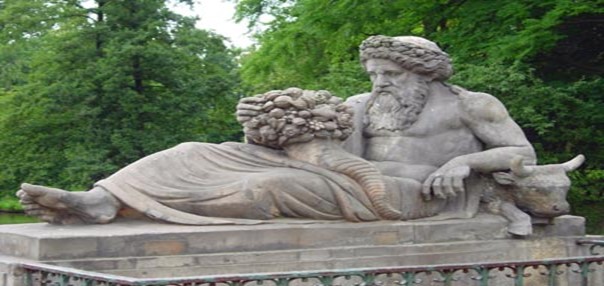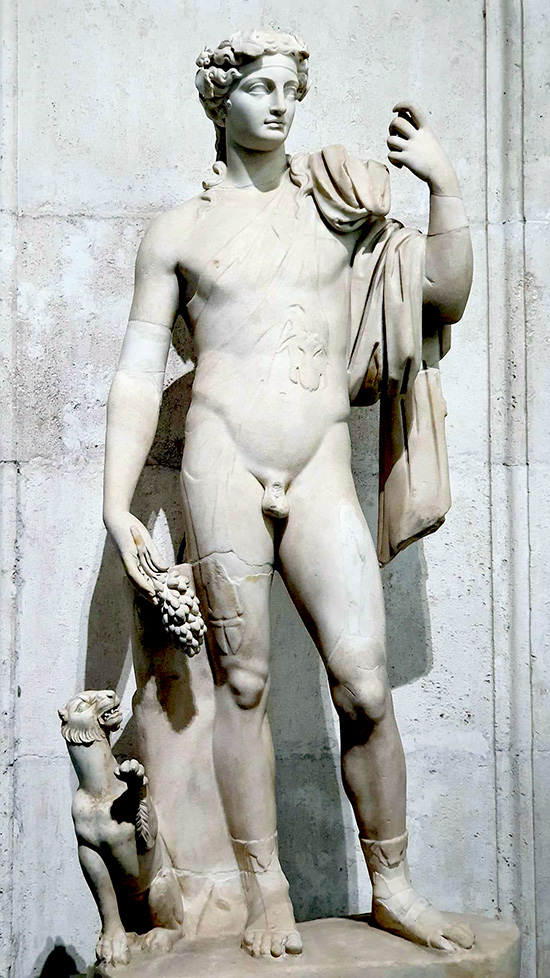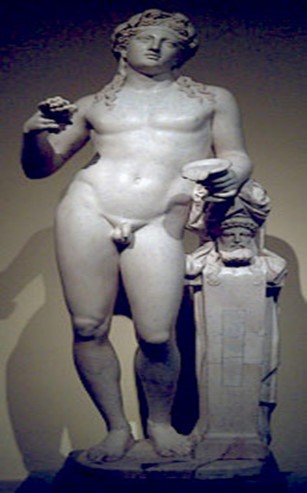Liber
LIBER PATER
L. Dellius Liberalis
Liber Pater: God of all those who plant the luscious grape, whose pleasant liquor makes all tables fare the better
(adapted from Ovid)
OVERVIEW
In the Cultus Deorum Romanorum, Liber, also known as Liber Pater ("the free Father"), was a god of viticulture and wine, male fertility, and freedom. He was a patron deity of Rome's plebeians and was part of their Aventine Triad. His festival of Liberalia (March 17) became associated with free speech and the rights attached to coming of age. Liber was closely, often interchangeably, identified with Bacchus, Dionysus, and their mythology; in the late Republican era, Cicero would insist on the "non-identity of Liber and Dionysus" and describe Liber and Libera as children of Ceres. Cicero’s insistences aside, his cult and functions were increasingly associated with Romanised forms of the Greek Dionysus and Bacchus, whose iconography and mythology he came to share, until they were completely fused . Cicero speaks of three Libers and ascribes different functions and connotations to the different appellations – which represent three distinct philosophical, oratorial, rhetorical, and epistolographic perspectives with which Liber was viewed, at least by Cicero . However, Q. Lucilius Balbus suggests that the need to separate the “Greek” Liber (Semele natum) from the “Roman” Liber stems from the fact that neither the name Dionysus nor Bacchus is used. Elsewhere however, Cicero appears to refer to Liber when pointing out the positive aspects of the Roman god, his festival and associated cult; to use the name Bacchus metonymically for wine, its consequences, and its generally negative derivatives; and Dionysus when discussing the Greek god and his genealogy. Following on from Varro , Augustine describes Liber as a god of the “seeds of men” and thus primarily represents male sexuality . Further to this, he represents the old-Italic Liber as a god of fecundity of agriculture, of viticulture, cattle-breeding, and possibly the personification of freedom.
ETYMOLOGY
The name Līber ('free') stems from Proto-Italic *leuþero , and ultimately from Proto-Indo-European *h₁leudʰero ('belonging to the people', hence 'free'). In Latin liber means "free", or the "free one"; when coupled with "pater", it means "The Free Father”, akin to the Greek Dionysus-Eleftherios . The word 'liber' is also understood to be the etymological root of ‘libation’, ritual offering of drink, although Varro argued in favour of the ‘liberation’ connection as opposed to ‘libation’, writing that “men were liberated through coitus with the emission of seed. For this reason, women used to place the effigy of the part of the body involved in his temples. They then added the attributes and some wine to excite the desire.” .
ATTRIBUTES
Liber, like Dionysus or Bacchus, was generally depicted as a young adult male wearing a crown of foliage and carrying a thyrsus (a stem of narthex or fennel topped by a pinecone). The thyrsus was one of Dionysus’ most distinctive attributes, and as the cults of Dionysus and Bacchus were merged with that of Liber, it too was adopted by the latter. Vines and grapes were naturally also important attributes of Liber. Liber was accompanied everywhere he went by an entourage known as the thiasos to the Greeks, of revelers and beasts, who were said to engage in nocturnal orgies . The thiasos included frenzied worshippers known as maenads, as well as satyrs and fauns— male nature spirits/creatures that were half-human and half-animal (with ears and a tail resembling those of a horse for the former and horns and legs of the goat for the latter, as well as a permanent, exaggerated erection for both). In Roman literature, Liber was often associated with the half-human, half-goat fauns. Public figures who wanted to associate themselves with Liber would occasionally adopt the god’s attributes, for example the politicians Pompey and M. Antonius sometimes represented themselves with the attributes of Liber , as did the controversial Roman emperor Elagabalus (218-222) of the Severan dynasty.
EPITHETS
Though Liber did indeed have a number of epithets found in literature, on statues, and on votive dedications to him, he is most often referred to as Liber Pater.
Here are a few examples of the most common:
Pater: Father
Bacchus: from Ancient Greek Βᾰ́κχος an epithet of the god Dionysus. That word Bakkhos was itself derived from the term bakkheia; a Greek word used to describe the frenzied, ecstatic state that the god produced in people. In appropriating the name “Bacchus,” then, the Latins were claiming an aspect of Dionysus for their own god. “Bacchus” could also be related to the Latin word bacca, meaning “a berry” or “the fruit of a tree or shrub.” In this context, such a word could be referencing grapes, the key ingredient in wine, though there is a theory within modern scholarship that now considers the possibility that both may in fact derive from the name of a Thracian fertility god.
Bromios: Noisy, Loud roaring (Becatti 1951, 10)
Lyeus/Lyæus: He who releases from care and anxiety (Becatti 1951, 10; Ovid, Metamorphoses 4, 1-27)
Nyctileus: the Night Sun (Ovid, Metamorphoses 4, 1-27)
Lenæus: Setter of Wine
Genialis consitor uva: God of all those who plant the luscious grape
Ovid's Metamorphoses, IV.I contains a number of epithets of Greek and Italic origin. Due to the fusion of the various cults that ended up shaping that of Liber Pater, epithets from those Greek, Etruscan, Samnite et al. cults entered Roman cult use.
FAMILY AND ASSOCIATED GODS
Ceres, Libera (Proserpina), and the Aventine Triad
In early Roman religion, the Italic goddess Libera was Liber’s female equivalent, whose pairing with the “Free father” appears to have been an "etymological duality" dating back to the end of the Regal or very early Republican eras . She enters Roman religious history as part of the so-called Aventine Triad alongside Ceres and Liber, whose cult was administered from their temple on the Aventine Hill established around 493 BC.
The Aventine relationship between Ceres, Liber and Libera was most likely based primarily on their functions as agricultural and fertility deities of the plebs as a distinct social group. Liber had been companion to both Ceres and to Libera in separate and disparate fertility cults that were widespread throughout the Hellenised Italian peninsula, long before their official adoption by Rome . Each of the Aventine triad's deities continued to receive cult in their own right. Liber's open, gender-mixed cult and festivals continued, though was spared any significant consequences following the suppression of the Bacchanalia. Libera’s individual cult (as Proserpina), as well as her joint cult with Ceres, eventually became widespread throughout the Republic and Empire. Libera was officially identified as Proserpina from 205 BC, when she and Ceres acquired a Romanised form of Greek mystery rite, the ritus graecus cereris . In the late Republican era, Cicero described Liber and Libera as Ceres' children. Both the older and newer forms of her names, cult, and rites, and their diverse associations, thrived and survived well into the late Imperial era.
MYTHOLOGY
One of Liber’s roles was that of a civilising god of humanity, a role upon which Ovid focused greatly, and in his Fasti Ovid connects Liber with Prometheus making him the first to offer a sacrifice – libamen - and with Aristaeus, as inventor of honey – et inventi praemia mellis habet.
“…they say that [Bacchus] discovered honey. He was travelling from sandy Hebrus, accompanied By Satyrs, (my tale contains a not-unpleasant jest) And he’d come to Mount Rhodope, and flowering Pangaeus: With the cymbals clashing in his companions’ hands. Behold unknown winged things gather to the jangling, Bees, that follow after the echoing bronze. Liber gathered the swarm and shut it in a hollow tree, And was rewarded with the prize of discovering honey. Once the Satyrs, and old bald-headed Silenus, had tasted it, They searched for the yellow combs in every tree.” (Ovid, Fasti.)
As we can see from the extract, Liber, his thiasos, Silenus and the satyrs (all very Dionysian dramatis personae) crossed the river Hebrus and were headed to Mt. Rhodope in usual boisterous fashion. The bees, or rather “flying creatures” (volucres) are attracted by the sound of drumming and chanting and fly in swarm towards them. Liber collects them and shuts them in the hollow of a tree and soothes them into producing the golden nectar, a small portion of which he then shares with his retinue, before temporarily taking his leave, perhaps to rest.
Silenus particularly enjoyed the delicious, sticky substance and begins searching for the sweet honey himself. After some searching, he finds the bees in the trunk. He stands on the back of his donkey trying to get the honey, but only disturbs the hive, which in turn results in him being stung on his nose and bald head. He falls off the donkey who then promptly kicks him. His cries alert the satyrs who begin to laugh at him. The Silenus-narrative also functions as a contrast to the episode with Liber. Like the god, the old satyr finds the bees, but due of his imperfection, the bees do not obey, but instead turn against him. Ovid himself also plays upon this duality in the line “melle pater fruitur” (761). On the first reading, we do not know to whom the poet is referring. It is at this point that Ovid identifies Liber as civiliser in the story of the unlucky Silenus. After Silenus experienced the bees’ real power, Liber returns in order to ease his pains. The god also instructs them how to lessen the pain caused by the stings of the bees: the satyr must smear his face with rich, fertile earth – the very same from which the vines themselves grow.
THE LIBERALIA, FESTIVAL OF LIBER
Liber's festivals are timed to the springtime awakening and renewal of fertility in the agricultural cycle. In Rome, his annual Liberalia festival was held on 17th March. A portable shrine was carried through Rome's vici. Liber's aged, ivy-crowned priestesses (Sacerdos Liberi) made special cakes, or liba, of oil and honey which passing devotees would have them sacrifice on their behalf – as the discovery of honey was credited to Liber-Bacchus. Embedded within the Liberalia, at a ritualistic level, were the various freedoms and rights attached to Roman ideas of virility as a divine and natural force . Young men of around 15 or 16 celebrated their coming of age to manhood; they cut off and dedicated their first beards to their household Lares, and placed the childhood bulla praetexta on the lararium (with a lock of hair or the stubble of that first shave placed inside) - mothers often retrieved the discarded bulla and kept it out of superstition. Should the son ever achieve a public triumph, the mother might display the bulla to ward off any evil that might be wished upon him by envious people.
If citizens, they would discard the toga praetexta and took up wearing the toga virilis, the which Ovid, poetically calls a toga libera (Liber's toga or "toga of freedom"). Having donned the toga virilis, the young men processed to the forum to register their citizenship and were then free to vote, to leave their father's domus, choose a marriage partner and, by the grace of Liber's endowment of virility, sire their own children and raise a family. The ceremony was a rustic one: the processional featured a large phallus which the devotees carried throughout the countryside to bring the blessing of fertility to the land and the people and protect the crops from evil. At the end of the procession, a virtuous and respected matron placed a wreath upon the phallus. Over time this feast evolved and included the goddess Libera, and the feast divided so that Liber governed the male seed, fertility, and freedom while Libera the female.
The Liberalia are attested in several sources, though Ovid’s account is quite particular. It is important to remember however that by the time of Ovid’s Fasti, the Aventine Triad were not among the gods with a significant State cult –the temple had been destroyed and wasn’t restored until 17AD – three years after Augustus’s death, and it is suggested that Ovid’s rebranding of Liber was necessary as he had been compromised by the Bacchic Affair of 186BC.
Virgil’s Georgics recount a rustic version of the feast of Liber, involving:
1. Slaughtering a goat
2. Theatre performances
3. Jumping on oily goatskins
4. Hanging masks on pine tree
All of which evoke the cult practices of Dionysus. Augustine recalls that in Lavinium, the Liberalia lasted one month and contained its original fertility cult elements: licentiousness, mischievousness and the phallic procession:
“tanta licentia turpitudinis: omnis verbis flagitiossimus uterentur… Nam hoc turpe membrum per Liberi dies festos cum honore magno plostellis impositum prius rure in comptis et usque in urbem postea vectabatur”.
Varro shares a number of common features with Ovid, including the honey cakes sold by the “old granny” priestesses: Liberalia dicta, quod per totum oppidum eo die sedent Sacerdotes Liberi anus hedera coronatae cum libis et foculo pro emptore sacrificantes.
It is important to point out that the licentious and mischievous behaviour found in both Virgil and Augustine’s narrative, as well as the accounts of Liber’s cults outside of Rome are missing from Ovid: as he was reformulating a more Roman Liber.
FOOTNOTES
1 Grimal (1996)
2 De Natura Deorum, 2:62
3 i) Semele natum – born of Semele (Dionysus) ii) cum Cerere et Libera consecraverunt - honuored with Ceres and Libera iii) ex mysteriis
intellegi potest – known by a mysteries religion.
4 MacGóráin (2019)
5 MacGóráin, 2019 p.165
6 MacGóráin (2019).
7 ARD, F 93C
8 De Civ. Dei, 4.11
9 De Vaan (2008)
10 Eleutherios Ἐλευθέριος ("the liberator")
11 Rerum Divinarum Libri, quoted by Augustine, De Civitate Dei, V, 9
12 Liberum a liberamentum appellatum volunt quod mares per eius beneficium emissis seminibus in coeundo liberentur. […] Et ob haec Libero eandem corporis parte in templo poni. Ad haec addunt mulieres attributas Libero et vinum propter libidimem concitandam
13 Catullus, Ode 64.251–64; Ovid, Metamorphoses 4.25–27; Virgil, Georgics 4.521
14 Valerius Maximus, Memorable Deeds and Sayings 3.6.6; Pliny the Elder, Natural History 33.150; Pliny the Elder, Natural History 8.2.4; Velleius Paterculus, Roman History 2.82.4.
15 Spaeth (1996) The Roman Goddess Ceres, p. 8
16 Wiseman, T.P (1988) "Satyrs in Rome? The Background to Horace's Ars Poetica", The Journal of Roman Studies, Vol. 78, p 7, note 52.
17 Spaeth (1996) pp. 4, 6–13, citing Arnobius, who mistakes this as the first Roman cult to Ceres. His belief may reflect the high profile and ubiquity of the "reformed" cult during the later Imperial period, and possibly the fading of older, distinctively Aventine forms of her cult.
18 Kovacs (2013)
19 Spaeth (1996).
20 a hollow charm of gold or leather, which parents placed about the necks of children to ward off evil spirits.
21 Wiseman (1998)
22 380-389
23 Civitate Dei, 7, 21
24 De Lingua Latina, 6:14
BIBLIOGRAPHY
Arena, V; (2020) The god Liber and the Republican Notion of Libertas in the Late Roman Republic. In: Balmaceda Errazuriz, C, (ed.) Libertas and Res Publica in the Roman Republic. (pp. 55-83). Brill: Leiden, The Netherlands.
Augustine of Hippo, De Civitate Dei Contra Paganos, (7,21)
Beard, M., North, J. & Price, S. (1998). Religions of Rome: Volume 2, A Sourcebook, Cambridge University Press.
Brogan, O P. F. & Wilson, R. J. A. (2012). "Lepcis Magna". In Hornblower, S., Spawforth, A., Eidinow, E (eds.). The Oxford Classical Dictionary (4th ed.). Oxford & New York: Oxford University Press. p. 821
Cicero, De Natura Deorum (2.6)
CIL - Corpus inscriptionum Latinarum, vol. III, 1873, 1902, cfr. Additamenta ad vol. III suppl. 4/1881; vol. V, 1872, 1877; vol. IX, 1883, Berlin
De Cazanove, O (1988). Jupiter, Liber et le Vin Latin, Revue de l’histoire des religions, tome 205, n˚3, pp 245-265.
de Vaan, Michiel (2008). Etymological Dictionary of Latin and the other Italic Languages. Brill.
Diotti, A (2010). Lingua Viva 1: Lezioni di Latino, Lingua e Civiltà, Scolastiche Bruno Mondadori: Pearson.
Forci, A (2011). L’Epigrafe di Bau Tellas (Senorbì, Cagliarì): Prime Attestazioni della Gens Arrecina e del Culto di Liber Pater in Sardegna.
Grimal, P (1996), The Dictionary of Classical Mythology, Wiley-Blackwell.
Isler-Kerényi, C (2011). The Cult of Liber/Bacchus in the Roman World.
Kenrick, P. M (1986). Excavations at Sabratha, 1948-1951: a report on the excavations conducted by Dame Kathleen Kenyon and John Ward-Perkins, London: Society for the Promotion of Roman Studies, on behalf of The Society for Libyan Studies.
Kenrick, P. M (2009). Tripolitania. Society for Libyan Studies (London, England). London: Society for Libyan Studies.
Kovacs, D (2015). Liberalia in Ovid, Liber in Roman Religion.
Kuivalainen, I (2021). The Pompeian Bacchus, Commentationes Humanarum Litterarum, Societas Scientiarum Fennica (The Finnish Society of Sciences and Letters)
Lipka, M (2009) Roman Gods: A Conceptual Approach, (Religions in the Graeco-Roman World), Boston: Leiden
Mac Córáin, F (2019) Dionysus and Rome: Religion and Literature, Berlin, Boston: De Gruyter
Manuwald, G (2020). Dionysus/Bacchus/Liber in Cicero.
Massa, F (2020). The Shadow of Bacchus: Liber and Dionysus in Christian Latin Literature (2nd-4th centuries, Dionysus and Rome: Religion and Literature
Masturzo, N (2005). Il Tempio Occidentale – ‘Tempio di Liber Pater’, I Tre Templi del Lato Nord-Ovest del Foro Vecchio a Leptis Magna.
Miano, D (2019) Liber, Fufluns, and the others: rethinking Dionysus in Italy between the fifth and the third centuries BCE. In: Mac Góráin, F., (ed.) Dionysus and Rome: Religion and Literature. Trends in Classics (93). De Gruyter, pp. 111-132.
Ovid, Fasti (3. 785-786)
Price, S and Kearns, E (eds) (2003) The Oxford Dictionary of Classical Myth and Religion (2003). Oxford University Press.
Richardson jr, L (1992). A New Topographical Dictionary of Ancient Rome, Baltimore, London, The Johns Hopkins Univrsity Press.
Sanader, Mirjana. (2008). On the cults of Antiquity in Croatia. Vjesnik za Arheologiju i Povijest Dalmatinsku. 101. 157 – 186
Santapau Pastor, M. del C (2005). La Impronta Simbólica de Liber Pater en Los Rituales y El Consumo de Vino en Hispania Romana. El Caso de Segobriga. Revista Murciana de Antropología, (12), 109–132.
Tomas, A. (2015) Liber Pater or Dionysus? The Evidence of the Bacchic Cult at Novae (castra et canabae legionis) and in its Hinterland, in Tomas, A. & Sarnowski, T. (eds.) Ad fines Imperii Romani. Warsaw: Institute of Archaeology, University of Warsaw.
Varro, De Linga Latina, (6,14)
Wiseman, T. P. (1998) Roman Drama and Roman History.
Wyler, S (2019). Loufir/Liber at the Crossroads of Religious Cultures in Pompeii (third-second centuries BC), Routledge.
Zaninović, M (1997) Liberov natpis iz Vrsara, Arheološka istraživanja u Istri, Izdanja Hrvatskog arheološkog društva 18, Zagreb 137-141.
ONLINE RESOURCES
Barron, C. (2019). Restoration of the temple of liber pater, Sabratha (IRT 55) - [1]
Borbonus , D., & Haselberger, L. (n.d.). Ceres, Aedes. Digital Augustan Rome. Retrieved March 2023, from [2]
De Santis, Giovanni (2022). Liberalia e Bacchanalia – 17 marzo – Ad Maiora Vertite [www.admaioravertite.org]
Glavčić, M (2002) The Cult of Liber in Ancient Senia - [hrcak.srce.hr/clanak/27844]
Le Bonniec, H (1958). “Le culte de Cérès à Rome des origines à la fin de la République” in Jean Gagé (1962) Revue de l'histoire des religions, tome 161, n°2, pp. 233-239.
Lepelley, C (1979). Les cités d’Afrique romaine au Bas-Empire, Paris: Études augustiniennes.
Matthews, K. D (1957). Cities in the Sand Leptis Magna and Sabratha in Roman Africa – [3]
Marmouri, K (2017) Temple de Liber Pater ou Capitole? Antiquités africaines, vol˚53 2017, 5-21.
Santuario C, Il tempio dionisiaco in località Sant’Abbondio di Pompei. - [[4]]
Rousselle, R. (1987). Liber-Dionysus in Early Roman Drama. The Classical Journal, 82(3), 193–198. [5]
Smith, William (1867) Libero & Libera, Dictionary of Greek and Roman Biography and Mythology – [6] Tempio Ædes Cereris Liberi Liberæ - [www.romanoimpero.com]
Valchev, I (2020) The Cult of Liber Pater and Dionysus in the Lower Danubian provinces during the Late Roman Period, Encyclopedia of Late Antique Balkans – [labalkans.org]
Wyler, S (2013). Dionysos/Loufir/Liber et sa parèdre : Le fronton du temple et le culte de S. Abbondio, Mélanges de l'École Française de Rome - Antiquité [En ligne], 125-1, mis en ligne le 23 octobre 2013



